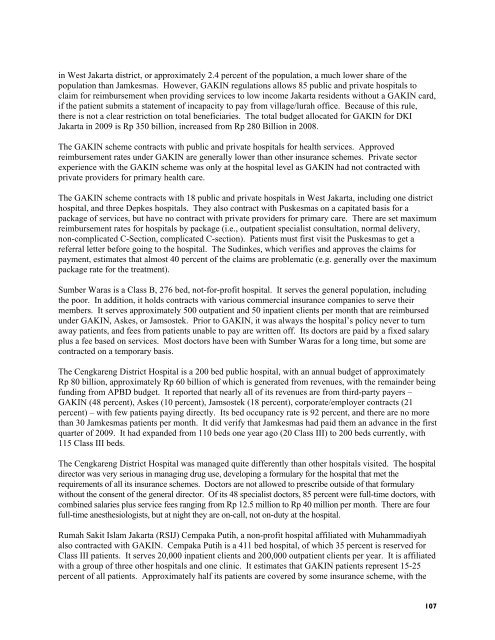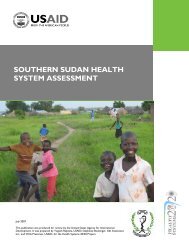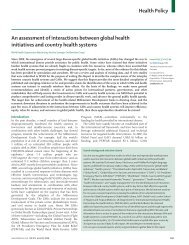PRIVATE SECTOR HEALTH CARE IN INDONESIA - Health Systems ...
PRIVATE SECTOR HEALTH CARE IN INDONESIA - Health Systems ...
PRIVATE SECTOR HEALTH CARE IN INDONESIA - Health Systems ...
- No tags were found...
You also want an ePaper? Increase the reach of your titles
YUMPU automatically turns print PDFs into web optimized ePapers that Google loves.
in West Jakarta district, or approximately 2.4 percent of the population, a much lower share of thepopulation than Jamkesmas. However, GAK<strong>IN</strong> regulations allows 85 public and private hospitals toclaim for reimbursement when providing services to low income Jakarta residents without a GAK<strong>IN</strong> card,if the patient submits a statement of incapacity to pay from village/lurah office. Because of this rule,there is not a clear restriction on total beneficiaries. The total budget allocated for GAK<strong>IN</strong> for DKIJakarta in 2009 is Rp 350 billion, increased from Rp 280 Billion in 2008.The GAK<strong>IN</strong> scheme contracts with public and private hospitals for health services. Approvedreimbursement rates under GAK<strong>IN</strong> are generally lower than other insurance schemes. Private sectorexperience with the GAK<strong>IN</strong> scheme was only at the hospital level as GAK<strong>IN</strong> had not contracted withprivate providers for primary health care.The GAK<strong>IN</strong> scheme contracts with 18 public and private hospitals in West Jakarta, including one districthospital, and three Depkes hospitals. They also contract with Puskesmas on a capitated basis for apackage of services, but have no contract with private providers for primary care. There are set maximumreimbursement rates for hospitals by package (i.e., outpatient specialist consultation, normal delivery,non-complicated C-Section, complicated C-section). Patients must first visit the Puskesmas to get areferral letter before going to the hospital. The Sudinkes, which verifies and approves the claims forpayment, estimates that almost 40 percent of the claims are problematic (e.g. generally over the maximumpackage rate for the treatment).Sumber Waras is a Class B, 276 bed, not-for-profit hospital. It serves the general population, includingthe poor. In addition, it holds contracts with various commercial insurance companies to serve theirmembers. It serves approximately 500 outpatient and 50 inpatient clients per month that are reimbursedunder GAK<strong>IN</strong>, Askes, or Jamsostek. Prior to GAK<strong>IN</strong>, it was always the hospital’s policy never to turnaway patients, and fees from patients unable to pay are written off. Its doctors are paid by a fixed salaryplus a fee based on services. Most doctors have been with Sumber Waras for a long time, but some arecontracted on a temporary basis.The Cengkareng District Hospital is a 200 bed public hospital, with an annual budget of approximatelyRp 80 billion, approximately Rp 60 billion of which is generated from revenues, with the remainder beingfunding from APBD budget. It reported that nearly all of its revenues are from third-party payers –GAK<strong>IN</strong> (48 percent), Askes (10 percent), Jamsostek (18 percent), corporate/employer contracts (21percent) – with few patients paying directly. Its bed occupancy rate is 92 percent, and there are no morethan 30 Jamkesmas patients per month. It did verify that Jamkesmas had paid them an advance in the firstquarter of 2009. It had expanded from 110 beds one year ago (20 Class III) to 200 beds currently, with115 Class III beds.The Cengkareng District Hospital was managed quite differently than other hospitals visited. The hospitaldirector was very serious in managing drug use, developing a formulary for the hospital that met therequirements of all its insurance schemes. Doctors are not allowed to prescribe outside of that formularywithout the consent of the general director. Of its 48 specialist doctors, 85 percent were full-time doctors, withcombined salaries plus service fees ranging from Rp 12.5 million to Rp 40 million per month. There are fourfull-time anesthesiologists, but at night they are on-call, not on-duty at the hospital.Rumah Sakit Islam Jakarta (RSIJ) Cempaka Putih, a non-profit hospital affiliated with Muhammadiyahalso contracted with GAK<strong>IN</strong>. Cempaka Putih is a 411 bed hospital, of which 35 percent is reserved forClass III patients. It serves 20,000 inpatient clients and 200,000 outpatient clients per year. It is affiliatedwith a group of three other hospitals and one clinic. It estimates that GAK<strong>IN</strong> patients represent 15-25percent of all patients. Approximately half its patients are covered by some insurance scheme, with the107
















